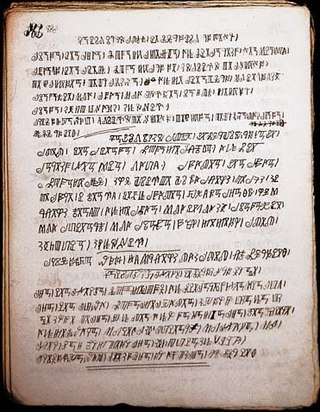Related Research Articles
Abau is a Papuan language spoken in southern Sandaun Province of Papua New Guinea, primarily along the border with Indonesia.

Bamum, also known as Shupamem, Bamun, or Bamoun, is an Eastern Grassfields language of Cameroon, with approximately 420,000 speakers. The language is well known for its original script developed by King Njoya and his palace circle in the Kingdom of Bamum around 1895. Cameroonian musician Claude Ndam was a native speaker of the language and sang it in his music.

The Bafia (Baepak) people are a central African ethnic group that inhabit the Mbam and Sanaga River regions in the Centre Region of Cameroon. They are culturally related to the Bamum and Tikar people.

Cameroon is home to at least 250 languages, with some accounts reporting around 600. These include 55 Afro-Asiatic languages, two Nilo-Saharan languages, four Ubangian languages, and 169 Niger–Congo languages. This latter group comprises one Senegambian language (Fulfulde), 28 Adamawa languages, and 142 Benue–Congo languages . French and English are official languages, a heritage of Cameroon's colonial past as a colony of both France and the United Kingdom from 1916 to 1961. Eight out of the ten regions of Cameroon are primarily francophone, representing 83% of the country's population, and two are anglophone, representing 17%. The official percentage of French and English speakers by the Presidency of Cameroon is estimated to be 70% and 30% respectively.

The Kwasio language, also known as Ngumba / Mvumbo, Bujeba, and Gyele / Kola, is a language of Cameroon, spoken in the south along the coast and at the border with Equatorial Guinea by some 70,000 members of the Ngumba, Kwasio, Gyele and Mabi peoples. Many authors view Kwasio and the Gyele/Kola language as distinct. In the Ethnologue, the languages therefore receive different codes: Kwasio has the ISO 639-3 code nmg, while Gyele has the code gyi. The Kwasio, Ngumba, and Mabi are village farmers; the Gyele are nomadic Pygmy hunter-gatherers living in the rain forest.
Baka is a dialect cluster of Ubangian languages spoken by the Baka Pygmies of Cameroon and Gabon. The people are ethnically close related to the Aka, collectively known as the Mbenga (Bambenga).However, the languages are not related, apart from some vocabulary dealing with the forest economy, which suggests the Aka may have shifted to Bantu, with an estimated 15000 people have shifted.
The Noni language, also called Noone, is an Eastern Beboid language of the Niger–Congo family in Cameroon. The Noone, Ncane, and Mungong varieties are sometimes considered three distinct Noni languages. Ethnologue reports that Ncare is 88% lexically similar with Noone, and 84% with Saari (Nsari).
Mbule, also called Dumbule or Mbola, is an endangered Southern Bantoid language spoken by a few people in central Cameroon.
Tikar is a Northern Bantoid, semi-Bantu language that is spoken in Cameroon by the Tikar people, as well as by the Bedzan Pygmies, who speak their own dialect of the language. A recent hypothesis by Roger Blench suggests that the Tikar language could be a divergent language in the Niger-Congo language family with an uncertain origin.
Eton, or Ìtón, is a Bantu language spoken by the Eton people of Cameroon.
Vemgo-Mabas is an Afro-Asiatic language of Cameroon and Nigeria. Dialects are Vemgo, Mabas. Blench (2006) considers these to be separate languages. Ethnologue lists a third dialect, Visik in Nigeria, which is not well attested; Blench suspects it may be a dialect of Lamang instead.
Kaalong (Kàlòng) also known as Dimbong (Mbong), is an almost extinct Bantu language from the Center Province of Southern Cameroon.
Mesaka, or Ugarə, is a Tivoid language spoken in Cameroon.
Mmen (Bafmeng) is a Grassfields Bantu language of Cameroon.
Mfumte (Nfumte) is a Grassfields Bantu language of Cameroon. It is not clear if the four varieties spoken by ethnic Mfumte—Ndaktup, Kwaja, Fum and Mfumte proper—are mutually intelligible or distinct languages; ability to communicate may be either due to inherent intelligibility or to bilingualism, while Fum and Mfumte may simply be the Nigerian and Cameroonian names for the same language.
Hijuk is a nearly extinct Bantu language of Cameroon. Guthrie had left it unclassified within the Bafia languages (A.50), but according to Ethnologue, it has only 31% lexical similarity with Bafia, and 87% with Basaa.
Leti, or Mangisa, is a Bantu language of Cameroon, spoken by the Mengisa people. Most Mengisa have switched to the Eton language, though a number of them continue to use Leti as a secret ritual language. A smaller number speak Leti as their mother tongue.
Spurious languages are languages that have been reported as existing in reputable works, while other research has reported that the language in question did not exist. Some spurious languages have been proven to not exist. Others have very little evidence supporting their existence, and have been dismissed in later scholarship. Others still are of uncertain existence due to limited research.

Ghailene Chaalali is a Tunisian professional footballer who plays as a midfielder for Tunisian Ligue Professionnelle 1 club Espérance de Tunis and the Tunisia national team.
Bafia is a town in the Centre Province of Cameroon.
References
- ↑ Bafia at Ethnologue (18th ed., 2015) (subscription required)
- ↑ Jouni Filip Maho, 2009. New Updated Guthrie List Online
- 1 2 3 Bafia Archived 2011-12-18 at the Wayback Machine , Ethnologue, 1991, access date 30-03-2012
- ↑ "ISO 639-3 Registration Authority" (PDF). Archived from the original (PDF) on May 13, 2015.